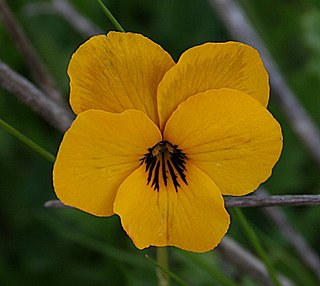
Viola pedunculata, the California golden violet, Johnny jump up, or yellow pansy, is a perennial yellow wildflower of the coast and coastal ranges in California and northwestern Baja California. The common name "Johnny jump up" is usually associated with Viola tricolor however, the introduced garden annual.

Viola riviniana, the common dog-violet, is a species of the genus Viola native to Eurasia and Africa. It is also called wood violet and dog violet. It is a perennial herb of woodland edges, grassland and shady hedge banks. It is found in all soils except acid or very wet.
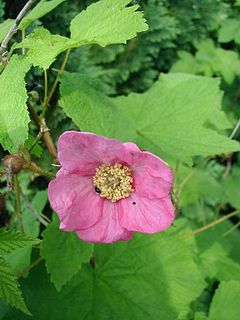
Rubus odoratus, the purple-flowered raspberry, flowering raspberry, or Virginia raspberry, is a species of Rubus, native to eastern North America, from Nova Scotia west to Ontario and Wisconsin, and south along the Appalachian Mountains as far as Georgia and Alabama.

Cornus alternifolia is a species of flowering plant in the dogwood family Cornaceae, native to eastern North America, from Newfoundland west to southern Manitoba and Minnesota, and south to northern Florida and Mississippi. It is rare in the southern United States. It is commonly known as green osier, alternate-leaved dogwood, and pagoda dogwood.

Viola canadensis is more commonly known as Canadian white violet, Canada violet, tall white violet, or white violet. It is widespread across much of Canada and the United States, from Alaska to Newfoundland, south as far as Georgia and Arizona.
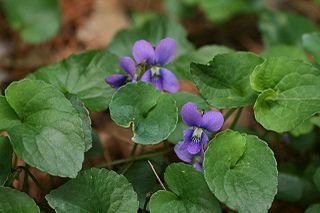
Viola cucullata, the hooded blue violet, marsh blue violet or purple violet, is a species of the genus Viola native to eastern North America, from Newfoundland west to Ontario and Minnesota, and south to Georgia. It is a recipient of the Royal Horticultural Society's Award of Garden Merit.
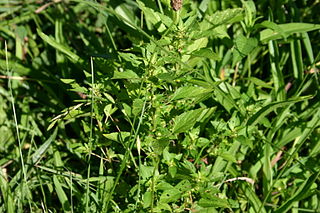
Acalypha rhomboidea is a plant in the spurge family, Euphorbiaceae.
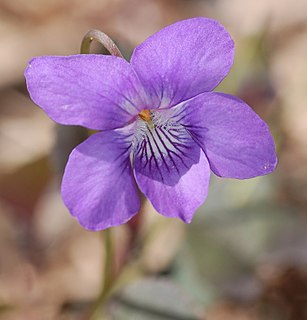
Viola labradorica, commonly known as alpine violet, American dog violet, dog violet, and Labrador violet, is a perennial. It is native to Greenland, eastern Canada, and the eastern United States. The plant sold as Viola labradorica by nurseries is Viola riviniana.
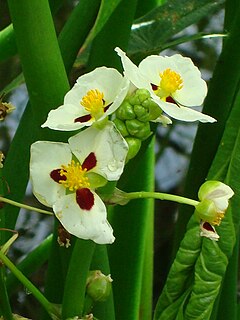
Sagittaria montevidensis is a species of flowering plant in the water-plantain family Alismataceae. Common names include giant arrowhead and California arrowhead.
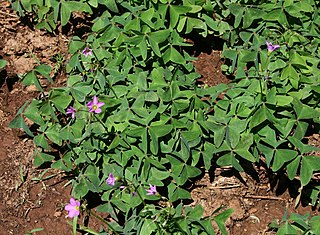
Oxalis latifolia is a species of flowering plant in the woodsorrel family known by the common names garden pink-sorrel and broadleaf woodsorrel. It is native to Mexico and parts of Central and South America.
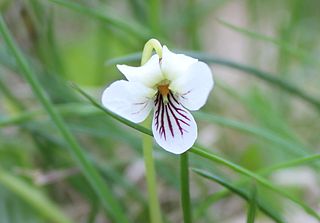
Viola macloskeyi is a flowering perennial plant in the violet family (Violaceae).

Viola pedatifida, known variously as prairie violet, crow-foot violet, larkspur violet, purple prairie violet, and coastal violet, is a perennial herbaceous plant in the Violet family (Violaceae). It is native to Canada and the United States.
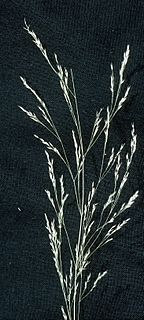
Agrostis perennans, the upland bentgrass, upland bent, or autumn bent, is a species of flowering plant in the grass family, Poaceae.
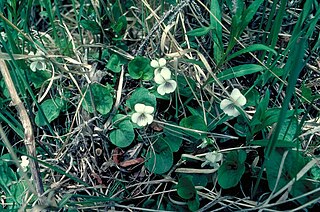
Viola renifolia is a species of violet known by the common names white violet and kidneyleaf violet. It is native to northern North America, where it has a widespread distribution across Canada and the northern United States as far south as Washington, Colorado, and New York.
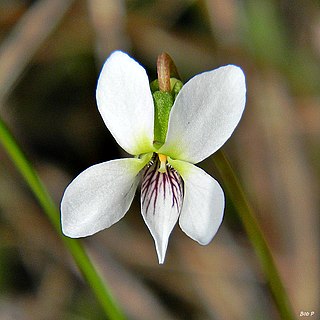
Viola lanceolata, commonly known as lance-leaved violet or bog white violet, is a small group of stemless white-flowered violets. It is an ornamental plant in the Violaceae family, part of the genus Viola. It gets its name from its lanceolate leaf shape and from the habitats in which it thrives.

Rosa blanda, commonly known as the smooth rose, meadow/wild rose, or prairie rose, is a species of rose native to North America. Among roses, it is closest to come to a "thornless" rose, with just a few thorns at the base. The meadow rose occurs as a colony-forming shrub growing to 1 m (3.3 ft) high, naturally in prairies and meadows. The roses are quite variable, the characteristics such as leaf tip number of prickles and glandular hairs usually do not always remain constant, thus it is often confused with Rosa arkansana or Rosa carolina, the two other prairie rose species.

Rubus flagellaris, the northern dewberry, also known as the common dewberry, is a North American species perennial subshrub species of dewberry, in the rose family. This dewberry is distributed across much of Canada, Mexico, and the United States. It grows in diverse habitats ranging from drier savannas to temperate deciduous forests.

Rubus allegheniensis is a species of bramble, known as Allegheny blackberry and simply as common blackberry. Like other blackberries, it is a species of flowering plant in the rose family. It is very common in eastern and central North America. It is also naturalized in a few locations in California and British Columbia.

Viola selkirkii is a species of violet known by the common names Selkirk's violet and great-spur violet. It is native throughout the Northern Hemisphere, its distribution circumboreal.
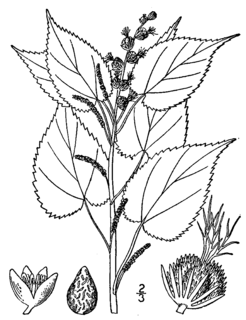
Acalypha ostryifolia, sometimes spelled ostryaefolia, is a plant in the family Euphorbiaceae and is commonly known as hophornbeam copperleaf, hornbeam copperleaf, or pineland threeseed mercury, is an annual herb of the copperleaf genus Acalypha. It is a native of North and Central America and is generally considered a weed.





















